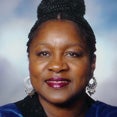Joanne Gabbin
Posted in Past Guests | Tagged G-M
 Joanne Gabbin was educated at Morgan State University and the University of Chicago. In 1994 Gabbin organized and directed the historic conference, “Furious Flower: A Revolution in African American Poetry,” which she called the “largest gathering of poets, critics, and scholars in more than two decades” dedicated to celebrating the African American poetic tradition. In 2004, Gabbin organized the second Furious Flower poetry conference. She is editor of Furious Flower: African American Poetry from the Black Arts Movement to the Present (2004) and The Furious Flowering of African American Poetry (1999), and executive producer of the Furious Flower video and DVD series. She is also author of a biography, Sterling A. Brown: Building the Black Aesthetic Tradition (1994), and a children’s book, I Bet She Called Me Sugarplum (2004). Gabbin’s articles have appeared in Callaloo, African American Review, The Zora Neale Hurston Forum, The Oxford Companion to Women’s Writing, the Langston Hughes Journal, The Oxford Companion to African American Literature, and others. In October 2005, Gabbin was inducted into the International Literary Hall of Fame for Writers of African Descent. She is founder and organizer of the Wintergreen Women Writers’ Collective, and owner of the 150 Franklin Street Gallery in Harrisonburg, Virginia. She is currently a professor of English at James Madison University where she is also director of the Honors Program and executive director of the Furious Flower Poetry Center.
Joanne Gabbin was educated at Morgan State University and the University of Chicago. In 1994 Gabbin organized and directed the historic conference, “Furious Flower: A Revolution in African American Poetry,” which she called the “largest gathering of poets, critics, and scholars in more than two decades” dedicated to celebrating the African American poetic tradition. In 2004, Gabbin organized the second Furious Flower poetry conference. She is editor of Furious Flower: African American Poetry from the Black Arts Movement to the Present (2004) and The Furious Flowering of African American Poetry (1999), and executive producer of the Furious Flower video and DVD series. She is also author of a biography, Sterling A. Brown: Building the Black Aesthetic Tradition (1994), and a children’s book, I Bet She Called Me Sugarplum (2004). Gabbin’s articles have appeared in Callaloo, African American Review, The Zora Neale Hurston Forum, The Oxford Companion to Women’s Writing, the Langston Hughes Journal, The Oxford Companion to African American Literature, and others. In October 2005, Gabbin was inducted into the International Literary Hall of Fame for Writers of African Descent. She is founder and organizer of the Wintergreen Women Writers’ Collective, and owner of the 150 Franklin Street Gallery in Harrisonburg, Virginia. She is currently a professor of English at James Madison University where she is also director of the Honors Program and executive director of the Furious Flower Poetry Center.
from Furious Flower: African American Poetry, An Overview
cracks into furious flower. Lifts its face
all unashamed. And sways in wicked grace.
-Gwendolyn Brooks
When Lucy Terry wrote “Bars Flight” (1746), the first poem written by an African in America, she set in motion a poetic tradition characterized by the furious pursuit of liberation in all of its dimensions as well as the cultivation of a cultural voice authenticated by its own distinctive oral forms and remembered, communal values. Speaking of this first development, Stephen Henderson in his seminal work Understanding the New Black Poetry (1972) writes that the idea of liberation permeated African American literary consciousness from slavery to the tumultuous 1960s, when poets reflected widespread disenchantment with white middle-class values and embraced cultural values emanating from Africa and the African diaspora. From Jupiter Hammon to Kevin Powell the idea of liberation has informed and energized African American poetry. African American poets have been creators and critics of social values as they envisioned a world of justice and equality. Nineteenth-century poets voiced the slaves’ complaint in the abolitionist struggle and rallied the troops in the cause of emancipation and freedom. African American poets in the twentieth century continued to rail against the status quo and protested attitudes and institutions that stood to impede the civil rights movement that changed the nature of American society. As these poets reflected African American concerns in the context of a larger American culture, they created a body of poetry that grew out of folk roots; legitimized poetry as a performative, participatory activity, and succeeded in creating an aesthetic tradition defined by communal values, the primacy of musicality and improvisation, and inventive style.
Continue reading “Furious Flower: African American Poetry, An Overview” at Modern American Poetry.
Media
Let Freedom Ring | April 16, 2008
SYMPOSIUM I | Art and Democracy in the King Years and Beyond: Scholarly Assessments
